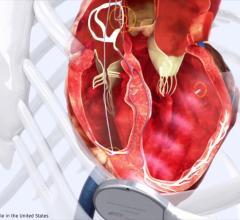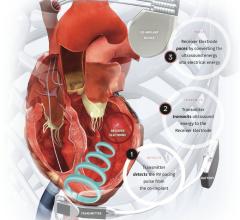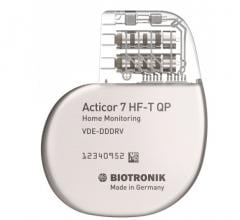
May 10, 2016 — The first-ever trial using new SonR hemodynamic sensor technology proves to be safely and effectively applied in cardiac resynchronization therapy (CRT) patients. Early performance results from the Clinical Response to Cardiac Resynchronization Therapy with the SonR Hemodynamic Sensor: The RESPOND-CRT Randomized Trial were presented at Heart Rhythm 2016, the Heart Rhythm Society’s 37th Annual Scientific Sessions, May 4-7 in San Francisco, and show reduction in hospitalizations for this patient population by 35 percent.
Sorin Group’s SonR technology uses a pressure sensor in the tip of the pacing lead to automatically optimize CRT-D therapy. This compensates for cardiac remodeling in heart failure patients. SonR is available in Europe and the RESPOND CRT is the U.S. pivotal trial.
CRT can relieve heart failure symptoms by improving the timing of the heart’s contractions, or beats, which protects patients from abnormally slow and fast heart rhythms. Although CRT is widely used to treat many heart failure patients, one-third of patients do not benefit from this therapy. The limited response to CRT can be reduced by echocardiographic optimization of atrioventricular (AV) and interventricular (VV) intervals during therapy. This method of optimization is known to be costly and time-consuming and requires skill and expertise, so it is usually undertaken only in ‘non-responder’ patients.
SonRtip lead (LivaNova) uses a hemodynamic sensor that uniquely measures the patient’s cardiac muscle vibrations in real-time and enables individualized automatic optimization of the AV and VV delays. In doing so, these measurements are then transmitted to the CRT device, which uses them to determine the best settings for the patient. Sorin Group claims SonR is the first and only system to provide weekly automatic optimization during a patient’s real-life activities.
The RESPOND-CRT trial is a prospective, multi-center, non-inferiority study involving patients with a CRT device who were randomized to receive either the SonRtip lead or the echocardiographic optimization. A total of 1,039 patients were enrolled in 125 sites in 12 countries from three continents, including North America.
Results of the study indicate that patients receiving automatic programming using the new SonRtip lead were more likely to respond to CRT than patients using echocardiographic optimization. Specifically, there was a 75 percent response rate for patients using the SonRtip lead versus a response rate of 70.4 percent for patients with echocardiographic optimization. Additionally, patients using the SonRtip lead saw a 35 percent reduction in heart failure-related hospitalizations. The primary efficacy non-inferiority endpoint and the co-primary safety endpoints of the study were met.
“With one-third of patients not responding properly to current CRT optimization methods, we saw the need to explore alternative methods to improve patient outcomes. This new SonR technology is the first system to automatically optimize for patients every week. Importantly, it works while the patient is active and therefore provides patients with a better way of life,” said Josep Brugada, M.D., Ph.D., Hospital Clínic de Barcelona. “This is a very promising technology for patients managing their heart failure and has the potential to become the new gold standard for CRT optimization.”
Study authors note the practical implication of this trial is to provide physicians with an alternative to echocardiographic optimization using an automated, hemodynamic-based algorithm for systematic AV and VV delays optimization. Pending additional long-term results, this approach could prove to be the superior CRT optimization method.
For more information: www.hrsonline.org


 April 25, 2025
April 25, 2025 








